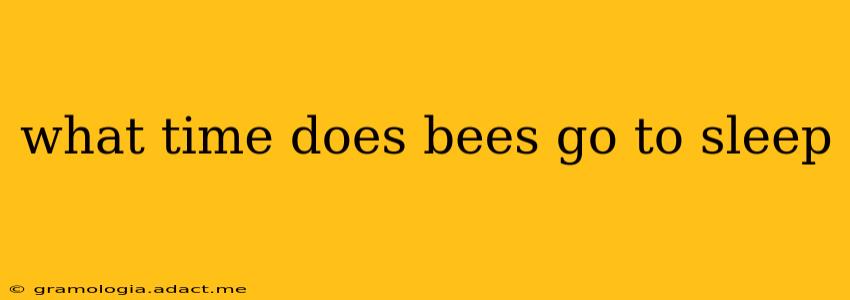What Time Do Bees Go to Sleep? The Buzz About Bee Sleep
Bees don't exactly "go to sleep" in the same way humans do. They don't have the same sleep cycles and consciousness as mammals. Instead, they exhibit a form of rest called torpor, which is a state of reduced metabolic activity. Understanding bee sleep involves understanding their complex social structure and individual needs.
What is bee torpor?
Bee torpor is a period of inactivity characterized by reduced movement and lowered body temperature. It's not a deep sleep like humans experience, but more of a resting state that allows them to conserve energy. The length and frequency of torpor vary depending on several factors, including the species of bee, the ambient temperature, and the bee's role within the colony.
Do all bees sleep at the same time?
No, bee sleep patterns aren't synchronized like a human family going to bed at night. The timing of rest depends heavily on their role in the hive.
-
Worker bees: These industrious insects rarely experience prolonged periods of uninterrupted rest. Their activity levels fluctuate throughout the day, with periods of inactivity interspersed with foraging, hive maintenance, and brood care. They may take short rests throughout the day, often lasting only a few minutes.
-
Queen bees: The queen, responsible for laying eggs, also needs rest, but her periods of inactivity might be longer than those of worker bees. She maintains a relatively consistent schedule, and her rest periods are crucial for her reproductive function.
-
Drone bees (males): Drone bees have a more relaxed schedule. Their main purpose is to mate with the queen, and after that, their lives are shorter. Their periods of inactivity might be longer than worker bees, but not necessarily as long as the queen's.
What factors influence bee rest?
Several environmental and internal factors influence when and how long bees rest:
-
Temperature: Cooler temperatures often trigger longer periods of rest. Bees are ectothermic (cold-blooded), meaning their body temperature is influenced by their surroundings.
-
Light levels: Changes in light levels can also signal rest periods. Bees are sensitive to light, and reduced light levels at dusk often correlate with increased inactivity.
-
Energy levels: Bees that have expended a lot of energy foraging or performing other tasks will likely rest more frequently and for longer durations.
-
Age: Younger bees tend to be more active, while older bees may take more frequent and longer rests.
How long do bees rest?
The duration of bee rest varies greatly. It can range from a few minutes of inactivity to several hours, depending on the factors mentioned above. It's important to note that continuous, deep sleep as experienced by humans is unlikely in bees.
Do bees sleep at night?
While bees don't have a strict sleep schedule like humans, they generally exhibit increased inactivity during the night. Darkness plays a role, but temperature and energy levels are also significant factors. They might cluster together for warmth and reduced energy expenditure during the cooler night hours.
Do bees dream?
This is a question that is still largely unanswered. While there's no direct evidence of dreaming in bees, the observation of periods of rest and inactivity suggests the possibility of some form of mental processing during these periods. More research is needed to understand the neurological processes behind bee rest.
In conclusion, while bees don't sleep in the human sense, they do have periods of inactivity and rest crucial for their survival and functioning within the colony. The timing and duration of this rest vary considerably based on factors like temperature, light, age, and their role in the hive. The intricacies of bee sleep are a fascinating area of ongoing research.
